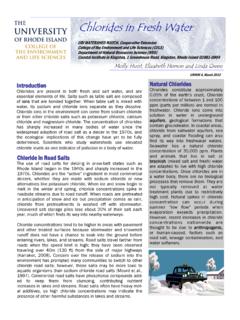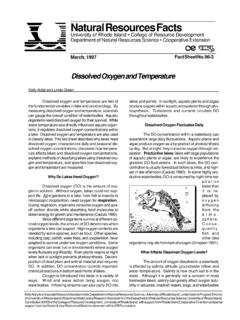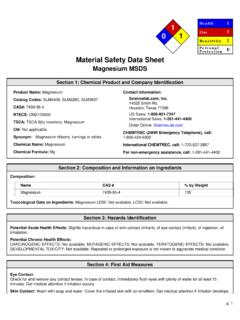Transcription of Chlorides in Fresh Water
1 Chlorides in Fresh Water URI WATERSHED WATCH, Cooperative Extension College of the Environment and Life Sciences (CELS). Department of Natural Resources Science (NRS). Coastal Institute in Kingston, 1 Greenhouse Road, Kingston, Rhode Island 02881-0804. Molly Hunt, Elizabeth Herron and Linda Green URIWW 4, March 2012. Introduction Natural Chlorides Chlorides are present in both Fresh and salt Water , and are Chlorides constitute approximately essential elements of life. Salts such as table salt are composed of the earth's crust. chloride of ions that are bonded together. When table salt is mixed with concentrations of between 1 and 100. Water , its sodium and chloride ions separate as they dissolve. ppm (parts per million) are normal in chloride ions in the environment can come from sodium chloride freshwater. chloride ions come into or from other chloride salts such as potassium chloride , calcium solution in Water in underground chloride and magnesium chloride .
2 The concentration of Chlorides aquifers, geological formations that has sharply increased in many bodies of Water since the contain groundwater. In coastal areas, widespread adoption of road salt as a deicer in the 1970s, and chloride from saltwater aquifers, sea the ecological implications of this change have yet to be fully spray, and coastal flooding can also determined. Scientists who study watersheds use elevated find its way into freshwater waters. chloride levels as one indicator of pollution in a body of Water . Seawater has a natural chloride concentration of 35,000 ppm. Plants and animals that live in salt or chloride in Road Salts brackish (mixed salt and Fresh ) Water The use of road salts for deicing in snow-belt states such as are adapted to live with high chloride Rhode Island began in the 1940s and sharply increased in the 1970s.
3 Chlorides are the active ingredient in most commercial concentrations. Once Chlorides are in a Water body, there are no biological deicers, whether they are made with sodium chloride or new processes that remove them. They are alternatives like potassium chloride . When ice and snow begin to melt in the winter and spring, chloride concentrations spike in not typically removed at Water treatment plants due to restrictively roadside streams due to road runoff. When roads are pretreated high cost. Natural spikes in chloride in anticipation of snow and ice but precipitation comes as rain, concentration can occur during chloride from pretreatments is washed off with stormwater. Uncovered salt storage piles lose about 20% of their salt each summer low flow periods when evaporation exceeds precipitation. year, much of which finds its way into nearby waterways.
4 However, recent increases in chloride chloride concentrations tend to be higher in areas with pavement concentrations nationwide are thought to be due to anthropogenic, and other treated surfaces because stormwater and snowmelt or human-caused, factors such as runoff does not have a chance to soak into the ground before entering rivers, lakes, and streams. Road salts travel farther from road salt, sewage contamination, and Water softeners. roads when the speed limit is high; they have been observed traveling over 40m (130 ft) from the side of major highways (Karraker, 2008). Concern over the release of sodium into the environment has prompted many communities to switch to other chloride road salts; however, these salts may be more toxic to aquatic organisms than sodium chloride road salts (Mount et al., 1997).
5 Commercial road salts have phosphorus compounds add- ed to keep them from clumping, contributing nutrient increases in lakes and streams. Road salts often have heavy met- al additives, so high chloride concentrations may indicate the presence of other harmful substances in lakes and streams. Page 2 Chlorides in Fresh Water , URI Watershed Watch Figure 1 (left): Uncovered Other chloride Sources Chlorides can also enter a watershed salt piles through Water softener discharge or such as this will lose 20% sewage contamination. Water of their salt to softeners remove magnesium and local waters calcium ions from hard Water by each year. performing an ionic exchange reaction with sodium chloride . Small amounts of sodium enter Water that Measuring Chlorides has passed through the softener, At URI Watershed Watch, volunteers collect Water samples for while magnesium chloride and chloride analysis in the spring and fall.
6 In the lab, chloride testing is calcium chloride are stored in the performed by Watershed Watch staff using a sophisticated autoan- device and eventually discharged as alyzer, which can quickly test a large number of samples. chloride brine into a sewer or septic system. test strips are also commercially available for home use. As salt intake continues to increase URI Watershed Watch volunteers monitoring use salinity in the American diet, more Chlorides refractometers or meters for estuaries, bays and the ocean. These are entering groundwater through devices measure concentration in parts per thousand and are human waste. Sodium chloride is therefore not sensitive enough for measuring Chlorides in Fresh added to many processed foods to Water . (A part per thousand is 1000 time more concentrated than a delay spoilage while bringing out part per million.)
7 Flavor. However, Chlorides are not removed from waste by septic tank treatment processes and enter the Figure 2 (left) and Figure 3 leach field with the rest of the (below): chloride effluent, or wastewater. From there, concentrations tend to be Chlorides can enter groundwater higher in bodies of Water through septic systems and find their surrounded by large way into lakes, ponds, streams, and developed areas with lots of wetlands. URI Cooperative Extension impermeable surfaces. Water Quality Program has Photos courtesy of Ken Wagner. assembled informative fact sheets about home wastewater treatment, septic system maintenance, and drinking Water quality that can be found online at A third anthropogenic source of Chlorides in groundwater is fertilizer made with potash, or mined salts. Potassium chloride is the salt most commonly used in potash fertilizer, and potassium (K on fertilizer bags) is one of three essential nutrients (along with N - nitrogen and P - phosphorous) that are added to increase soil fertility on farms and home gardens and lawns.
8 However, like nitrogen and phosphorous, chloride can leach from fertilized soils into rivers and streams. Page 3 Chlorides in Fresh Water , URI Watershed Watch Too Much chloride ? High chloride concentrations in freshwater can harm aquatic organisms by interfering with osmoregulation, the biological process by which they maintain the proper concentration of salt and other solutes in their bodily fluids. Difficulty with osmoregulation can hinder survival, growth, and reproduction. In Rhode Island, the Department of Environmental Management (DEM) has set acceptable chloride concentration exposure limits for freshwater organisms at 860 ppm to prevent acute (immediate) exposure effects and at 230 ppm to prevent chronic (long-term) exposure effects. For drinking Water , DEM has set a maximum contaminant level of 250 ppm chloride , which is the point at which Water starts to taste salty.
9 Some research suggests that, with certain exceptions, fish are less sensitive to chloride Figure 4 (above): Frogs and other amphibians lay their exposure than small, free-floating planktonic eggs in vernal pools, which are isolated from other Water crustaceans (Evans and Frick, 2001). These sources and do not have any process that flushes out planktonic animals are a food source for fish Chlorides . Amphibians such as these are especially and amphibians and help control the algae that vulnerable to high chloride levels as eggs and during contribute to eutrophication, nutrient metamorphosis. Photo by Thomas Tetzner. accumulation that depletes lakes of oxygen. Recent published research suggests that high chloride concentrations are harmful to many How Can I Help Keep Chlorides Out Of Our aquatic animals. Meador and Carlisle (2007) Waterways?
10 Found chloride tolerance levels for some brook Shovel early after a storm to minimize the need for trout species to be as low as ppm. Rhode deicers. Island's native spotted salamander has a 40% If you must use a deicer, consider a pre-wetted 1:1. reduction in survival when spawned in a vernal sand and road salt mixture to minimize the amount of pool with a chloride concentration over 162. ppm (Karraker, 2008). Vernal pools, temporary Chlorides released. bodies of Water , tend to have high chloride Apply deicers early and sparingly; extra salt will not concentrations in early spring, when eggs are melt ice faster! laid, and in summer, when larvae and tadpoles Do not deice with kitty litter, ashes, or any product undergo metamorphosis and become adults, containing urea. two especially delicate times in their lifecycle If you need a Water softener, consider a portable (Karraker, 2008).












